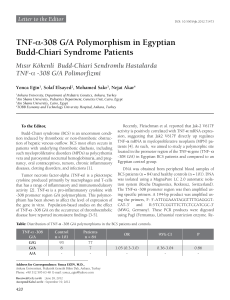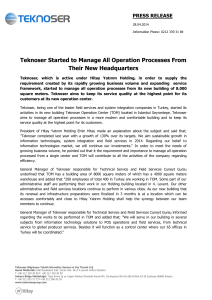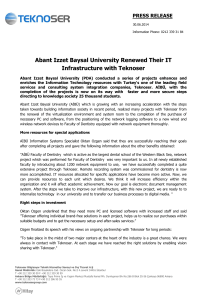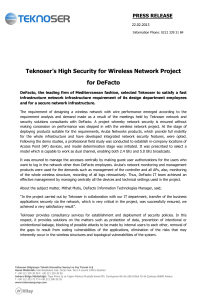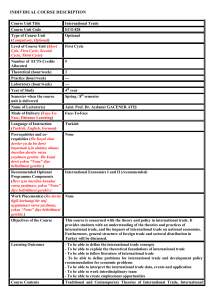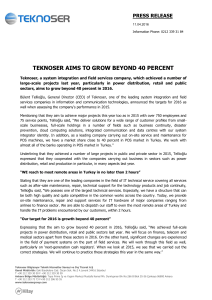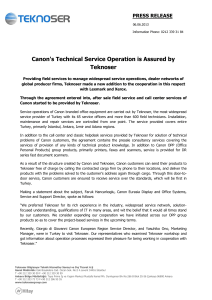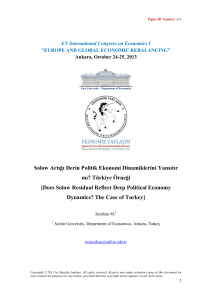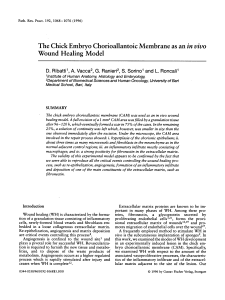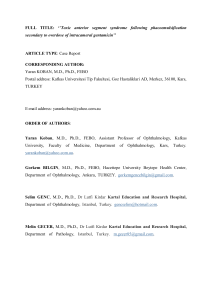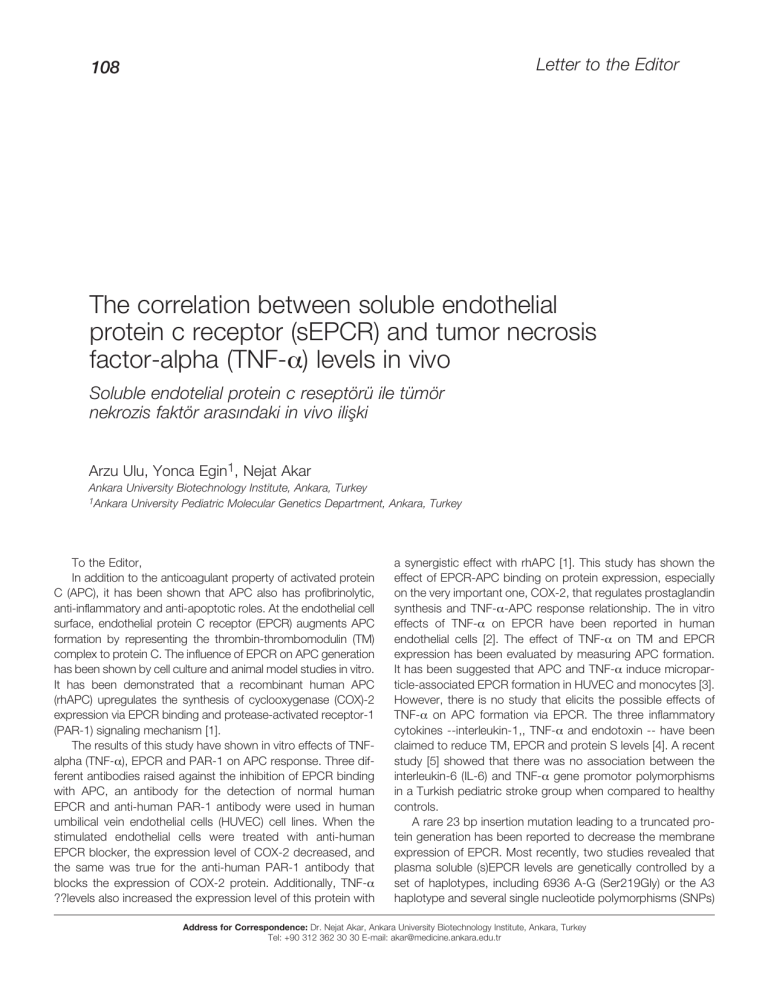
Letter to the Editor
108
The correlation between soluble endothelial
protein c receptor (sEPCR) and tumor necrosis
factor-alpha (TNF-α) levels in vivo
Soluble endotelial protein c reseptörü ile tümör
nekrozis faktör aras›ndaki in vivo iliflki
Arzu Ulu, Yonca Egin1, Nejat Akar
Ankara University Biotechnology Institute, Ankara, Turkey
1Ankara University Pediatric Molecular Genetics Department, Ankara, Turkey
To the Editor,
In addition to the anticoagulant property of activated protein
C (APC), it has been shown that APC also has profibrinolytic,
anti-inflammatory and anti-apoptotic roles. At the endothelial cell
surface, endothelial protein C receptor (EPCR) augments APC
formation by representing the thrombin-thrombomodulin (TM)
complex to protein C. The influence of EPCR on APC generation
has been shown by cell culture and animal model studies in vitro.
It has been demonstrated that a recombinant human APC
(rhAPC) upregulates the synthesis of cyclooxygenase (COX)-2
expression via EPCR binding and protease-activated receptor-1
(PAR-1) signaling mechanism [1].
The results of this study have shown in vitro effects of TNFalpha (TNF-α), EPCR and PAR-1 on APC response. Three different antibodies raised against the inhibition of EPCR binding
with APC, an antibody for the detection of normal human
EPCR and anti-human PAR-1 antibody were used in human
umbilical vein endothelial cells (HUVEC) cell lines. When the
stimulated endothelial cells were treated with anti-human
EPCR blocker, the expression level of COX-2 decreased, and
the same was true for the anti-human PAR-1 antibody that
blocks the expression of COX-2 protein. Additionally, TNF-α
??levels also increased the expression level of this protein with
a synergistic effect with rhAPC [1]. This study has shown the
effect of EPCR-APC binding on protein expression, especially
on the very important one, COX-2, that regulates prostaglandin
synthesis and TNF-α-APC response relationship. The in vitro
effects of TNF-α on EPCR have been reported in human
endothelial cells [2]. The effect of TNF-α on TM and EPCR
expression has been evaluated by measuring APC formation.
It has been suggested that APC and TNF-α induce microparticle-associated EPCR formation in HUVEC and monocytes [3].
However, there is no study that elicits the possible effects of
TNF-α on APC formation via EPCR. The three inflammatory
cytokines --interleukin-1‚, TNF-α and endotoxin -- have been
claimed to reduce TM, EPCR and protein S levels [4]. A recent
study [5] showed that there was no association between the
interleukin-6 (IL-6) and TNF-α gene promotor polymorphisms
in a Turkish pediatric stroke group when compared to healthy
controls.
A rare 23 bp insertion mutation leading to a truncated protein generation has been reported to decrease the membrane
expression of EPCR. Most recently, two studies revealed that
plasma soluble (s)EPCR levels are genetically controlled by a
set of haplotypes, including 6936 A-G (Ser219Gly) or the A3
haplotype and several single nucleotide polymorphisms (SNPs)
Address for Correspondence: Dr. Nejat Akar, Ankara University Biotechnology Institute, Ankara, Turkey
Tel: +90 312 362 30 30 E-mail: [email protected]
Turk J Hematol 2008; 25: 108-9
[6,7]. It has been suggested that membrane-bound EPCR is
cleaved by metalloproteinases and it increases the level of
sEPCR levels in the plasma. Increased levels of sEPCR cause
a shift in the role of EPCR, which functions as a modulator and
enhancer of APC generation by inhibiting the anticoagulant
activity of APC [8].
In this study, the possible effects of plasma sEPCR and
TNF-α levels were investigated in a group of 104 healthy controls together with the TNF-α promoter-308 G-A polymorphism and their associations. The mean age of the controls
was 28.58±7.8 and the median age was 25. The plasma levels of the parameters were determined by enzyme linked
immunosorbent assay (ELISA) according to the manufacturer’s
instructions using the commercially available Asserachrom®
sEPCR ELISA kit (Diagnostica Stago, Asnieres-France) and
TNF-α kits (Biosource International, USA). To determine TNFα–308 G-A polymorphism, a previously described technique
was performed [5].
For statistical analysis, SPSS statistical package version 11
was used. Pearson’scorrelation test was used to determine
any correlation between the levels of parameters in healthy
controls. Correlation was significant at the 0.01 level (2-tailed)
between TNF-α and sEPCR levels. The distributions of the
parameters assumed to be related were also compared by
using Wilcoxon signed rank test and the analysis gave positive
ranks (P=0.015). The relationship between TNF-α –308 G-A
polymorphism and sEPCR levels was comparedusing chisquare test, and odds ratios (OR) were calculated with 95%
confidence interval (CI). Two groups were generated according
to GG and GA genotypes of TNF-α gene polymorphism.
Among 84 individuals with TNF-α GG genotype, 12 were found
to have sEPCR levels higher than 100 ng/ml, and in the 20
TNF-α GA group, 3 individuals were found to have high levels
of sEPCR. These groups were compared with respect to their
sEPCR levels. The OR was 1.05 (CI: 0.27-4.07) and P value
was 0.77. The same approach was used for the TNF-α levels
and the promoter gene polymorphism.
Ulu et al.
Protein C receptor and tumor necrosis factor alpha
109
Our study is the first study to evaluate the in vivo effects of
TNF-α and sEPCR levels and to determine associations with
TNF-α gene polymorphism. Here, we report a correlation
between TNF-α and sEPCR levels among healthy controls,
whereas we were unable to find an association between the
TNF-α promoter gene variant and either plasma parameter
according to the performed risk analysis. The significant correlation between TNF-α and sEPCR levels may be attributable to
the low levels of the parameters among controls. We think that
this correlation should be analyzed in patients with thrombosis,
as a correct approach to determine the influences.
References
1. Brueckmann M, Horn S, Lang S, Fukudome K, Schulze Nahrup A,
Hoffmann U, Kaden JJ, Borggrefe M, Haase KK, Huhle G.
Recombinant human activated protein C upregulates cyclooxyge
nase-2 expression in endothelial cells via binding to endothelial cell
protein C receptor and activation of protease-activated receptor-I.
Thromb Haemost 2005;93:743-50.
2. Perez-Casal M, Downey C, Fukudome K, Marx G, Toh CH.
Activated protein C induces the release of microparticle-associated endothelial protein C receptor. Blood 2005;105:1515-22.
3. Nan B, Lin P, Lumsden AB, Yao Q, Chen C. Effects of TNF-α and
curcumin on the expression of thrombomodulin and endothelial
protein C receptor in human endothelial cells. Thromb Res
2005;115:417-26.
4. Dahlback B, Villoutreix BO. Regulation of blood coagulation by the
protein Canticoagulant pathway. Novel insights into structurefunction relationships and molecular recognition. Arterioscler
Thromb Vasc Biol 2005;25:1-10.
5. Karahan ZC, Deda G, Sipahi T, Elhan AH, Akar N. TNF-α –308
G/A and IL-6-174 G/C polymorphisms in the Turkish pediatric
stroke patients. Thromb Res 2005;115:393-8.
6. Saposnik B, Reny J, Gaussem P, Emmerich J, Aiach M, Gandrille
S. A haplotype of the EPCR gene is associated with increased
plasma levels of sEPCR and is a candidate risk factor for throm
bosis. Blood 2004;103:1311-8.
7. Uitte De Willige S, Van Marion V, Rosendaal FR, Vos HL, De Visser
MCH, Bertina RM. Haplotypes of the EPCR gene, plasma sEPCR
levels and the risk of deep venous thrombosis. J Thromb Haemost
2004;2:1305-10.
8. Liaw PC, Neuenschwander PF, Smirnov MD, Esmon CT.
Mechanisms by which soluble endothelial cell protein C receptor
modulates protein C and activated protein C function. J Biol Chem
2000;275:5447-52.


